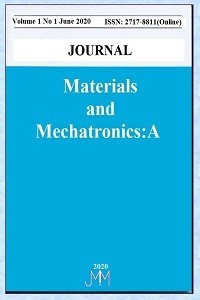AA6061 Serisi Alüminyum Plakalarına Yapılan MIG ve TIG Kaynak Tamirlerinin Tahribatlı ve Tahribatsız Testlerle İncelenmesi
Mevcut çalışma AA6061 plakaların MIG kaynak yöntemiyle birleştirilmesinin ardından MIG ve TIG kaynak yöntemleri kullanılarak üçer defa tamir işlemini kapsamaktadır. Kaynaklı numunelere tahribatlı ve tahribatsız testler uygulanmıştır. Gözle muayene ve sıvı penetrant testi sonuçlarına göre TIG kaynağı MIG kaynağına göre daha düzgün bir kaynak yüzeyi sergilemiş ve radyografik muayene sonuçlarında hataya rastlanmamıştır. Makroyapı incelemelerinde tamirat işleminin gözenek oluşumuna gözle görülür bir etkisinin olmadığı, mikroyapı incelemelerinde tamirat sayısı arttıkça ısı girdisine bağlı olarak ITAB bölgesinde tanelerin irileştiği belirlenmiştir. Sertlik değerleri ana metalden kaynak bölgesine doğru gidildikçe azalmış, çekme deneyi sonuçlarında ise MIG kaynağının TIG kaynağına göre daha yüksek mukavemet değerlerine sahip olduğu ve tamirat sayısı arttıkça mukavemet değerlerinin azaldığı tespit edilmiştir. SEM-EDS sonuçlarına göre tamirat sayısı arttıkça mukavemet arttırıcı görevi olan Mg’nin oranının azaldığı belirlenmiştir. XRD sonuçlarına göre alüminyum pikleri ile birlikte, Mg2Si’nin düşük şiddette pik verdiği gözlemlenmiştir.
Anahtar Kelimeler:
AA6061, ITAB, MIG kaynağı, Tahribatlı test, Tahribatsız test, TIG kaynağı
Investigation of MIG and TIG Welding Repairs on AA6061 Series Aluminum Plates by Destructive and Non-Destructive Tests
The study includes the joining of AA6061 plates with MIG welding method and then repairing three times using MIG and TIG welding methods. Destructive and non-destructive tests were applied to the welded samples. According to the results of visual inspection and liquid penetrant test, TIG welding exhibited a smoother weld surface than MIG welding, and no defect were found in the radiographic inspection results. It was determined that the repair process did not have a visible effect on the pore formation in the macrostructure examinations, and the grains in the HAZ region became coarser due to the heat input as the number of repairs increased in the microstructural examinations. The hardness values decreased from the base metal to the welding zone, and in the tensile test results, it was determined that MIG welding had higher strength values than TIG welding and the strength values decreased as the number of repairs increased. According to the SEM-EDS results, it was determined that as the number of repairs increased, the ratio of Mg, which has the task of increasing the strength, decreased. According to the XRD results, it was observed that Mg2Si gave low intensity peaks together with the aluminum peaks.
Keywords:
AA6061, Destructive test, Non-destructive test, HAZ, MIG welding, TIG welding,
___
- Akman A.B., Raylı Sistem Araçları Imalatında Kullanılan 6061 ve 5083 Alaşımlarının TIG ve MIG Kaynaklarının Tahribatlı ve Tahribatsız Muayene Yöntemleriyle Karşılaştırılması, Eskişehir Osmangazi Üniversitesi Fen Bilimleri Enstitüsü, Yüksek Lisans Tezi (Basılmış), 2018.
- Ambriz R.R., Barrera G., Garcia R., Lopez V.H., A Comparative Study of the Mechanical Properties of 6061-T6 GMA Welds Obtained by the Indirect Electric Arc (IEA) and the Modified Indirect Electric Arc (MIEA). Materials and Design 30 (7), 2446-2453, 2009.
- Bhatia A., Introduction to Welding and NonDestructive Testing (NDT), https://www.cedengineering.com/userfiles/Introduction%20to%20Welding%20&%20Non-Destructive%20Testing%20(NDT)%20-%20R1.pdf/ (Erişim Tarihi: 07.03.2023).
- Çüngür R., Kaynaklı ve Kaynaksız 5754 Alüminyum Alaşımının Korozif Ortamlardaki Çekme Davranışı, Pamukkale Üniversitesi Fen Bilimleri Enstitüsü, Yüksek Lisans Tezi (Basılmış), 2021.
- Debeski M.A.M., The Effect of Different Additional Wires on the Microstructure and Mechanical Properties of AISI 304L and AISI 430 Stainless Steels Combined with TIG Welding, Karabük University Graduate School of Natural and Applied Science, Master Thesis (Printed), 2017.
- Gönül E., Kaynaklı İmalatta Tahribatsız Muayene Ve Tahribatsız Muayene Metotları, https://www.mmo.org.tr/sites/default/files/users/zeynep/NDT%20METHODS%20FOR%20WELDING_Rev02.pdf/ (Erişim Tarihi: 07.03.2023).
- Hirose A., Kurosawa N., Kobayashi K.F., Todaka H., Yamaoka H., Quantitative Evaluation of Softened Regions in Weld Heat-Affected Zones of 6061-T6 Aluminum Alloy-Characterizing of the Laser Beam Welding Process. Metallurgical and Materials Transactions A 30, 2115-2120, 1999.
- Kamat S.K., Kumar A., An Experimental Investigation of Mechanical Properties of Al 6106 T6 Alloy Joined by Friction Stir Welding and TIG Welding. International Journal of Innovations in Engineering and Technology 3 (1), 246–253, 2013.
- Khafaji L.A., The Effect of Welding Methods in the Weldment Design on the Distortions, Hardness and Stresses Generation of Steel Type S355J2C+N, Türk Hava Kurumu University Graduate School of Natural and Applied Science, Doctoral Thesis (Printed), 2020.
- Kocaman A.G., Demirer A., AA6061 T6 Alüminyum Alaşımında Bilyeli Dövme İşleminin Mekanik Özelliklere Etkisinin İncelenmesi. Afyon Kocatepe Üniversitesi Uluslararası Mühendislik Teknolojileri ve Uygulamalı Bilimler Dergisi 4 (2), 49-58, 2021.
- Kumar P., Arif A., Prasad A.C.V.S., Danaiah P., Singh A.K., Patro M., Kishore K.S., Murugan M., Study of Welding Process Parameter in TIG Joining of Aluminum Alloy (6061). Materials Today: Proceedings 47 (13), 4020-4025, 2021.
- Malin V., Study of Metallurgical Phenomena in the HAZ of 6061-T6 Aluminum Welded Joints. Welding Journal 305-318, 1995.
- Okay S., Investıgatıon of Mechanical Property Changes After MIG Welding of (7XXX) Series Aluminum Alloys, Middle East Technical University Graduate School of Natural and Applied Sciences, Master Thesis (Printed), 2016.
- Prakash J., Tewari S.P., Srivastava B.K., Shielding Gas For Welding of Aluminium Alloys by TIG/MIG Welding A Review. International Journal of Modern Engineering Research 1 (2), 690-699, 2012.
- Singh L., Singh R., Singh N.K., Singh D., Singh P., An Evaluation of TIG Welding Parametric Influence on Tensile Strength of 5083 Aluminium Alloy. International Journal of Mechanical, Industrial Science and Engineering 7 (11), 1262–1265, 2013.
- Withers P.J., Residual Stress and Its Role in Failure. Reports on Progress in Physics 70, 2211-2264, 2007.
- Yayın Aralığı: Yılda 2 Sayı
- Başlangıç: 2020
- Yayıncı: Yusuf KAYALI
Sayıdaki Diğer Makaleler
Umit TAYFUN, Çağrıalp ARSLAN, Mehmet DOĞAN
Pomza Taşının Otomotiv Sürtünme Malzemesi Olarak Kullanımının Araştırılması
Emin ÇENGELCİ, Hüseyin BAYRAKÇEKEN
Mert Eren AYĞAHOĞLU, Mehmet Sefa GÜMÜŞ, Abdullah ÇAKAN, Mete KALYONCU
Elle Kaldırma Hareketinde Kutu Boyutunun L5/S1 Eklemine Etkisinin İncelenmesi
Melih CANLIDİNÇ, Mustafa GÜLEŞEN
Bulanık Mantık Denetleyicisi ile Volan Ters Sarkacın Denge Kontrolü
Hüseyin Oktay ERKOL, Cemil KÖZKURT
Isıl İşlemin Bakır Kaplı Çelik Boruların Mekanik Özelliklerine Etkisinin Araştırılması
Ozan KOYUNCU, Burak ÇELİK, Yasin AKGÜL, Alper İNCESU
Çok Fonksiyonlu Akıllı Masa Saati
İlaç-İlaç Etkileşimlerini Keşfetmek: Bir Ağ Analizi ve Görselleştirme Yaklaşımı
